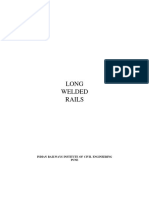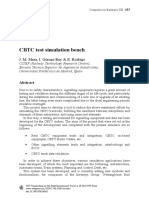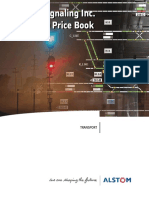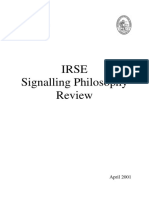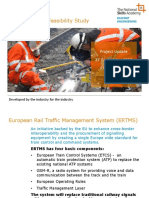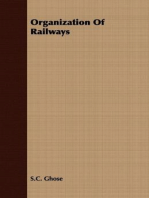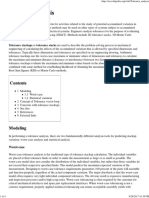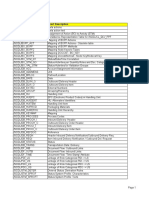At a glance
Powered by AI
The key takeaways are that Dubai Metro has the longest fully automated driverless metro system in the world and was the first to introduce Communication Based Train Control signalling in the Middle East region.
Dubai Metro Signalling & Train Control System Page 1 of 10
DUBAI METRO SIGNALLING & TRAIN CONTROL SYSTEM
Shiv Mohan, CEng, BTech, MIRSE, PMP, MIET, MIEEE, Serco Dubai Metro
SUMMARY
This paper is a case study of Dubai Metro Signalling & Train Control system.
Dubai Metro is the world’s longest fully Automated Driverless Metro System. Dubai Metro has taken the lead role to introduce Communication Based Train Control in the Arabian Peninsula. It probes into the reasons why Dubai Metro has gone for CBTC signalling & train control system. It details the features of Dubai Metro signalling & train control system and enumerates the implementation & operation challenges faced by Dubai Metro, benefits and lessons learnt there from. It also gives an overview of the signalling requirements of different upcoming lines & extension of Dubai Metro. The success of Dubai Metro has shown a path to upcoming Metro systems in the Arabian Peninsula like Kuwait Metro, Makkah Metro, Abu Dhabi metro and Doha metro.
In this paper we shall also discuss the important issues & future challenges like specific environment issues, interoperability in view of the fast changing transport scenario in the Middle East.
1
INTRODUCTION
An efficient transport system is the key root of economic growth of any country. The rapid worldwide expansion in requirement of an urban transport system in the last few years has led to the planning and development of mass rapid transit systems in the Middle East. Success of such a system lies in the ability to provide frequent, fast, safe and comfortable journeys to a large number of regular travellers & tourists. The phenomenal advancements in the fields of electronic & software systems have enabled metro signalling to develop intelligent train protection, operation and railway control systems, and signalling plays a major role in their ability to achieve these aims. Dubai Metro has taken care to introduce all the modern trends in Metro rail signalling, and accordingly has gone ahead with modern Communication Based Train Control signalling system, which is the first one of its kind in the Middle East.
2
DUBAI METRO- NEED & FEASIBILITY
Like all modern cities of the world, Dubai transportation needs are growing rapidly due to increasing demand generated by upward trend of international business relocations, swell in commercial activities, growth of tourism and increasing population. As part of its modernity drive, vision and concerns for the environment, the Dubai Government commissioned studies to evaluate the most efficient and cost-effective solution to combat traffic congestion and its pollution by-product; the recommendation of these studies were the creation and development of a Metro for Dubai City. As a city grows in size, the number of motor vehicles and consequently the numbers of vehicular trips on road systems go up, leading to severe congestion on the roads. This necessitates a pragmatic policy shift to discourage private modes and encourage public transport, once the level of traffic along any travel corridor in one direction exceeds 20,000 persons per hour. A comprehensive study about growing need of mass transport brought out the need of a Dubai Metro. A rail based metro has a high carrying capacity and is non–polluting. It uses about one-fifth energy per passenger-km compared to a road based system. Moreover, it is fast, reliable, safe and comfortable to commuters. The Metro system planned for Dubai consists of both underground and surface corridors covering a total route of 74.6 km. It consists of two lines totaling 47 stations, of which 10 stations are underground, 36 elevated & 1 graded station. The Red Line has a capacity of 23,000 people per hour in each direction, and the Green Line is able to shuttle 19,000 people per hour. In May 2005, Dubai Metro design and build contract was awarded to the Dubai Rail Link (DURL) consortium made up of companies including Mitsubishi Heavy Industries, Mitsubishi Corporation, Obayashi Corporation,
Dubai Metro Signalling & Train Control System Page 2 of 10
Kajima Corporation and Yapı Merkezi. Work officially commenced on the construction of the metro on 21 March 2006. The Dubai Metro is the flagship Project of the Roads and Transport Authority (RTA)Dubai. The Red line was opened 9 minutes and 9 seconds past 9 PM on 9 September 2009 (9/9/9 9:9:9) and the Green line was opened on 9/9/11. The first two lines are shown in Table 1.
Lines
Sections
Trains Depots Length (Km)
No. of Stations
Red Line Rashidiya – Jebel Ali 44 2 52.1 29 Green Line Al Qusais- Creek 17 1 22.5 20
Total
61 3 74.6 47 ( 2 common stations)
Table 1: Dubai Metro Lines
Dubai Metro is the world's second most affordable metro transportation system after Tehran Metro in Iran. Dubai Metro has generated substantial benefits by: 1.
Contributing to the appreciation of the value of lands & commercial properties as much as by 7 to 34%.
2.
Generating high economic returns highlighted by its ability of the competitiveness of the Dubai as regards the attraction of commercial activities as well as the local & international events spanning conferences and sports events.
3.
Generating the revenues for Dubai by advertising activities, naming of stations (Corporate branding) and leasing of commercial outlets.
4.
Siphoning off commuter trips per day from the roads of Dubai. This will translate into fewer Cars cars & buses on Dubai roads increase in average speed of road traffic, saving of fuel cost, reduction in pollution levels and reduction in road accidents.
5.
Improving work productivity by saving total man-per day and reducing commuter stress. 6.
Changing the lifestyle by encouraging commuters to spend more time reading during their journeys and increasing people interaction between different communities & nationalities.
Figure 1: Dubai Metro Map
Dubai Metro Signalling & Train Control System Page 3 of 10
3
REQUIREMENTS OF SIGNALLING SYSTEM OF DUBAI METRO
The green and red lines Automatic Train Control (ATC) system is based on state-of-art, yet proven in use; communications based train control technology, using continuous bidirectional digital communications between intelligent trains and a network of distributed trackside computers designed for very high system reliability and availability. The primary characteristic requirements of the ATC system include: 1.
High resolution train location determination by trainborne equipment. 2.
Communications of train location information and other train status data to trackside computers over train to trackside communication link. 3.
Determination of movement authority limit information for each intelligent train based on train location information and processed input from the trackside interlocking. 4.
Communication of these authority limits and other train control data to the appropriate train over the trackside to trains communication link. 5.
Determination and enforcement of the safe speed distance profile by the trainborne equipment. 6.
Central supervisory computers, the Automatic Train Supervision (ATS) system, provide train scheduling and general operating and control information to provide optimal system throughput, control and flexibility. 7.
The train control system provides short interval, great operational flexibility, safety through continuous over-speed protection, smooth and predictable operation, high reliability and availability, optimized maintenance tasks. 8.
The ATC system shall make provision for the insertion of new stations within the lines as well as provision for lines extension
.
9.
The normal train control system shall be communication-based. Equipment reliability, redundancy, and system architecture ensure that the operation of the system continue in the presence of any single point failure. 10.
The ATC system shall be designed such that equipment failure rates shall be sufficiently low to preclude the need for manual driving operation, which shall be exceptional in case of failure. 11.
Under normal operation, ATC automatic mode shall require no Operation Control Centre (OCC) staff intervention other than supervision and minimum OCC staff intervention when out of normal operation. 12.
Any equipment failure or line interruption shall be instantly reported to OCC and lead to minimal service disruption, as high availability requirements shall be met. In case of significant failure, the system shall then fallback to alternative modes of operation under OCC staff full supervision. 13.
In normal operations, train will stop at every station. Under degraded mode of operation it shall be, however, possible to modify the standard configuration, skip a station or all the stations (through train). 14.
Initialisation of automatic operation after system start up must be possible without manual intervention locally in each train, nor require OCC operator command to be made for each train. 15.
All parts of the ATC system including trackside and on-board computers shall be capable of being remotely commanded to restart. 16.
The ATC system shall provide core functions of Automatic Train Protection(ATP), Automatic Train Operation (ATO) and Automatic Train Supervision (ATS). 17.
The design headway shall be such as to allow an operational ultimate headway of 90 seconds for a station dwell time of 20 seconds. 18.
The design life of all ATC equipment in service shall be 20 years. 19.
ATC shall provide automatic station stopping. ATO station stops shall be accurate within:
•
+/- 0.25 metres of the designated stop location at least 99.90 % of the time
.
•
+/- 0.5 metre of the designated stop location at least 99.99 % of the time.
Dubai Metro Signalling & Train Control System Page 4 of 10
3.1
Automatic Train Protection (ATP)
The ATC system shall provide the maximum safe operating flexibility and allow all safe operating running. This sub-system, which is concerned with fundamental safety of train operation, performs the following functions: 1.
The ATP shall detect the presence of trains and any maintenance vehicles
.
2.
Ensure and maintain safe operation between trains. 3.
Detect the speed & determine the maximum safe speed at the train location, for comparison with the actual train speed. 4.
Ensure that the train deceleration rate used for braking is reached within specified time of service brake application, otherwise application of emergency brake takes place. 5.
Detect “roll back” of the train and cause brake application. 6.
Detect an unexpected loss of train integrity and establish appropriate limits of authority to prevent other trains from entering in that area. 7.
Provide Movement of Authority & Train and Platform Screen door safe protection. 8.
Wayside and On-board Obstacle detection and Protection. 9.
Provide Securing of routes and Switch Interlocking.
3.2
Automatic Train Operation (ATO)
The ATO function shall provide commands to vehicle subsystems, in particular the propulsion unit, to ensure reliable and comfortable service for passengers as described below: 1.
Control Train acceleration, deceleration, and station stop. 2.
Control the vehicle speed to meet the acceleration and jerk limit requirements, minimize runtimes or adapt runtimes to OCC regulation needs, avoid unnecessary power/brake transitions, avoid over speed conditions, provide the smoothest practical ride for passengers. 3.
Control the station dwell as per service regulation needs. 4.
Command platform screen doors and train doors to simultaneously close, proceeded by an audio and visual signal for passenger information. 5.
Programmed Station Stop. 6.
Address other sub functions (i.e. Train identification, PSD control, Train departure testing, Train health monitoring, automatic route initialisation, Route selection etc.)
3.3
Automatic Train Supervision (ATS)
This computer-based sub-system overall controls from the Operations Control Centre (OCC) and stations and include the following functions: 1.
Execution of instructions received from train controller. 2.
Direct a train or group of trains to skip a station or group of stations. 3.
Enable the OCC or the station master office to hold a train in a station. 4.
Train dispatching & adjustment of station dwell time. 5.
Provision of output to platform indicators and/or other passenger/management information media. 6.
Commands to station interlocking & computation of train schedules. 7.
Monitoring of train position and progress. 8.
Display of train service status to train controller. 9.
Logging and compilation of records. 10.
Interface with other sub systems such as Onboard system.













